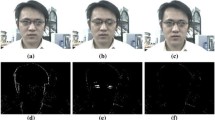Abstract
This paper presents a face liveness detection system against spoofing with photographs, videos, and 3D models of a valid user in a face recognition system. Anti-spoofing clues inside and outside a face are both exploited in our system. The inside-face clues of spontaneous eyeblinks are employed for anti-spoofing of photographs and 3D models. The outside-face clues of scene context are used for anti-spoofing of video replays. The system does not need user collaborations, i.e. it runs in a non-intrusive manner. In our system, the eyeblink detection is formulated as an inference problem of an undirected conditional graphical framework which models contextual dependencies in blink image sequences. The scene context clue is found by comparing the difference of regions of interest between the reference scene image and the input one, which is based on the similarity computed by local binary pattern descriptors on a series of fiducial points extracted in scale space. Extensive experiments are carried out to show the effectiveness of our system.
Similar content being viewed by others
References
Jain, A., Bolle, R., & Pankanti, S. (1999). Biometrics: personal identification in networked society. Berlin: Springer.
Schuckers, S. (2002). Spoofing and anti-spoofing measures, information security technical report (Vol. 7, pp. 56–62). Amsterdam: Elsevier.
Bigun, J., Fronthaler, H., & Kollreider, K. (2004). Assuring liveness in biometric identity authentication by real-time face tracking. In: IEEE international conference on computational intelligence for homeland security and personal safety (CIHSPS’04) (pp. 104–111), 21–22 July 2004.
Parthasaradhi, S., Derakhshani, R., Hornak, L., & Schuckers, S. (2005). Time-series detection of perspiration as a liveness test in fingerprint devices. IEEE Trans. Syst. Man Cybern., 35(3), 335–343.
Antonelli, A., Cappelli, R., Maio, D., & Maltoni, D. (2006). Fake finger detection by skin distortion analysis. IEEE Trans. Inf. Forensics Secur., 1(3), 360–373.
Zhao, W., Chellappa, R., Phillips, J., & Rosenfeld, A. (2003). Face recognition: a literature survey. ACM Comput. Surv., 35, 399–458.
Frischholz, R. W., & Dieckmann, U. (2000). BioID: a multimodal biometric identification system. IEEE Comput., 33(2), 64–68.
Kollreider, K., Fronthaler, H., Faraj, M. I., & Bigun, J. (2007). Real-time face detection and motion analysis with application in liveness assessment. IEEE Trans. Inf. Forensics Secur., 2(3), 548–558.
Frischholz, R. W., & Werner, A. (2003). Avoiding replay-attacks in a face recognition system using head-pose estimation. In IEEE international workshop on analysis and modeling of faces and gestures (AMFG’03) (pp. 234–235).
Choudhury, T., Clarkson, B., Jebara, T., & Pentland, A. (1999). Multimodal person recognition using unconstrained audio and video. In Proc. 2nd int. conf. audio-video based person authentication (AVBPA’99) (pp. 176–181), Washington, DC, 1999.
Kollreider, K., Fronthaler, H., & Bigun, J. (2009). Non-intrusive liveness detection by face images. Image Vis. Comput., 27(3), 233–244.
Pan, G., Sun, L., Wu, Z. H., & Lao, S. H. (2007). Eyeblink-based Anti-Spoofing in Face Recognition from a Generic Webcamera. In The 11th IEEE international conference on computer vision (ICCV’07), Rio de Janeiro, Brazil, 14–20 October 2007.
Li, J. W., Wang, Y. H., Tan, T. N., & Jain, A. K. (2004). Live face detection based on the analysis of Fourier spectra, biometric technology for human identification. SPIE, 5404, 296–303.
Socolinsky, D. A., Selinger, A., & Neuheisel, J. D. (2003). Face recognition with visible and thermal infrared imagery. Comput. Vis. Image Underst., 91(1–2), 72–114.
Chetty, G., & Wagner, M. (2006). Multi-level liveness verification for face-voice biometric authentication. In Biometrics symposium 2006, Baltimore, Maryland, 19–21 Sep. 2006.
Kollreider, K., Fronthaler, H., & Bigun, J. (2008). Verifying liveness by multiple experts in face biometrics, In IEEE computer society conference on computer vision and pattern recognition workshop on biometrics (pp. 1–6).
Karson, C. (1983). Spontaneous eye-blink rates and dopaminergic systems. Brain, 106, 643–653.
Tsubota, K. (1998). Tear dynamics and dry eye. Prog. Retin. Eye Res., 17(4), 565–596.
Lafferty, J., McCallum, A., & Pereira, F. (2001). Conditional random fields: probabilistic models for segmenting and labeling sequence data. In Proc. 18th int. conf. machine learning (pp. 282–289).
Li, S. Z. (2001). Markov random field modeling in image analysis. Berlin: Springer.
Rabiner, L. R. (1989). A tutorial on hidden Markov models and selected applications in speech recognition. Proc. IEEE, 77(2), 257–286.
Freund, Y., & Schapire, R. E. (1997). A decision-theoretic generalization of on-line learning and an application to boosting. J. Comput. Syst. Sci., 55(1), 119–139.
Viola, P., & Jones, M. J. (2004). Robust real-time face detection. Int. J. Comput. Vis., 57(2), 137–154.
Lowe, D. G. (2004). Distinctive image features from scale-invariant keypoints. Int. J. Comput. Vis., 60(2), 91–110.
Ojala, T., Pietikäinen, M., & Mäenpää, T. (2002). Multiresolution gray scale and rotation invariant texture classification with local binary patterns. IEEE Trans. Pattern Anal. Mach. Intell., 24(7), 971–987.
Heikkilä, M., & Pietikäinen, M. (2006). A texture-based method for modeling the background and detecting moving object. IEEE Trans. Pattern Anal. Mach. Intell., 28(4), 657–662.
Ahonen, T., Hadid, A., & Pietikäinen, M. (2006). Face description with local binary patterns: application to face recognition. IEEE Trans. Pattern Anal. Mach. Intell., 28(12), 2037–2041.
Jones, J., & Palmer, L. (2006). An evaluation of the two dimensional Gabor filter model of simple receptive fields in cat striate cortex. J. Neurophys., 58(6), 1233–1258.
Wiskott, L., Fellous, J. M., Kruger, N., & Malsburg, C. (1997). Face recognition by elastic bunch graph matching. IEEE Trans. Pattern Anal. Mach. Intell., 19(7), 775–779.
Author information
Authors and Affiliations
Corresponding author
Rights and permissions
About this article
Cite this article
Pan, G., Sun, L., Wu, Z. et al. Monocular camera-based face liveness detection by combining eyeblink and scene context. Telecommun Syst 47, 215–225 (2011). https://doi.org/10.1007/s11235-010-9313-3
Published:
Issue Date:
DOI: https://doi.org/10.1007/s11235-010-9313-3




